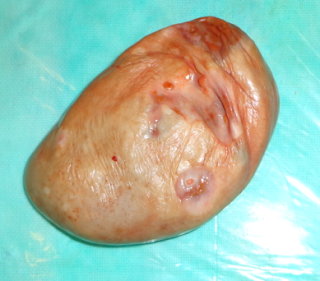A 45 years old woman presented with third degree uterine prolapse, cystocele, rectocele and lax perineum. She had had no symptoms of acute abdominal pain in the past. We performed a vaginal hysterectomy, anterior colporrhaphy, vault suspension and posterior colpoperineorrhaphy on her. After division of the uterine vessels, I noticed a dirty yellowish colored cystic structure above and behind the uterine corpus. I removed the uterus. Then I held the structure with Babcock's forceps and made traction. It delivered without any resistance. It had absolutely no attachment to any intraperitoneal structure.
It was soft, cystic, flaccid, and tended to flatten out when placed on a flat surface. The surface did not show any place where a pedicle could have necrosed and set it free in the peritoneal cavity. I inspected both the ovaries and found them to be normal. I cannot put a picture of the operative field showing the ovaries because that would show body parts which may be considered objectionable by some viewers and also by Google who gives me free space for this blog. Histopathology of the cyst showed degenerated cyst possibly of ovarian origin.
"Sir, where did it come from?" a Resident doctor asked me.
"I would have said one of the ovaries. But the ovaries are all normal. An ovarian cyst develops within an ovary, not from the surface of an ovary with a pedicle that can undergo necrosis and set the cyst free. If the ovary with a cyst in it undergoes torsion and gets detached, the cyst may become free, but it would contain the ovary too, not leave it behind. It cannot have been a broad ligament cyst, because it was above and behind the uterus. If it had been in the broad ligament, we would have seen it before clamping the uterine vessels. Broad ligament cysts do not escape into the peritoneal cavity anyway."
"Why don't you publish it in a scientific journal?" a colleague asked me.
"These days many journals ask for a lot of money to publish articles. Those which do not do so ask silly questions about the content and their reviewers pass comments which if made by exam going students would result in them being failed. Anyway the readership of my blog is large enough for me to be happy as a teacher. I know how many people read my given article in my blog, which is not what I can say about my article in a local scientific journal. After all, a blog post disseminates scientific information as much as a scientific journal, if not more. It is free too, while most journals ask money from readers too."
It was soft, cystic, flaccid, and tended to flatten out when placed on a flat surface. The surface did not show any place where a pedicle could have necrosed and set it free in the peritoneal cavity. I inspected both the ovaries and found them to be normal. I cannot put a picture of the operative field showing the ovaries because that would show body parts which may be considered objectionable by some viewers and also by Google who gives me free space for this blog. Histopathology of the cyst showed degenerated cyst possibly of ovarian origin.
"Sir, where did it come from?" a Resident doctor asked me.
"I would have said one of the ovaries. But the ovaries are all normal. An ovarian cyst develops within an ovary, not from the surface of an ovary with a pedicle that can undergo necrosis and set the cyst free. If the ovary with a cyst in it undergoes torsion and gets detached, the cyst may become free, but it would contain the ovary too, not leave it behind. It cannot have been a broad ligament cyst, because it was above and behind the uterus. If it had been in the broad ligament, we would have seen it before clamping the uterine vessels. Broad ligament cysts do not escape into the peritoneal cavity anyway."
"Why don't you publish it in a scientific journal?" a colleague asked me.
"These days many journals ask for a lot of money to publish articles. Those which do not do so ask silly questions about the content and their reviewers pass comments which if made by exam going students would result in them being failed. Anyway the readership of my blog is large enough for me to be happy as a teacher. I know how many people read my given article in my blog, which is not what I can say about my article in a local scientific journal. After all, a blog post disseminates scientific information as much as a scientific journal, if not more. It is free too, while most journals ask money from readers too."
